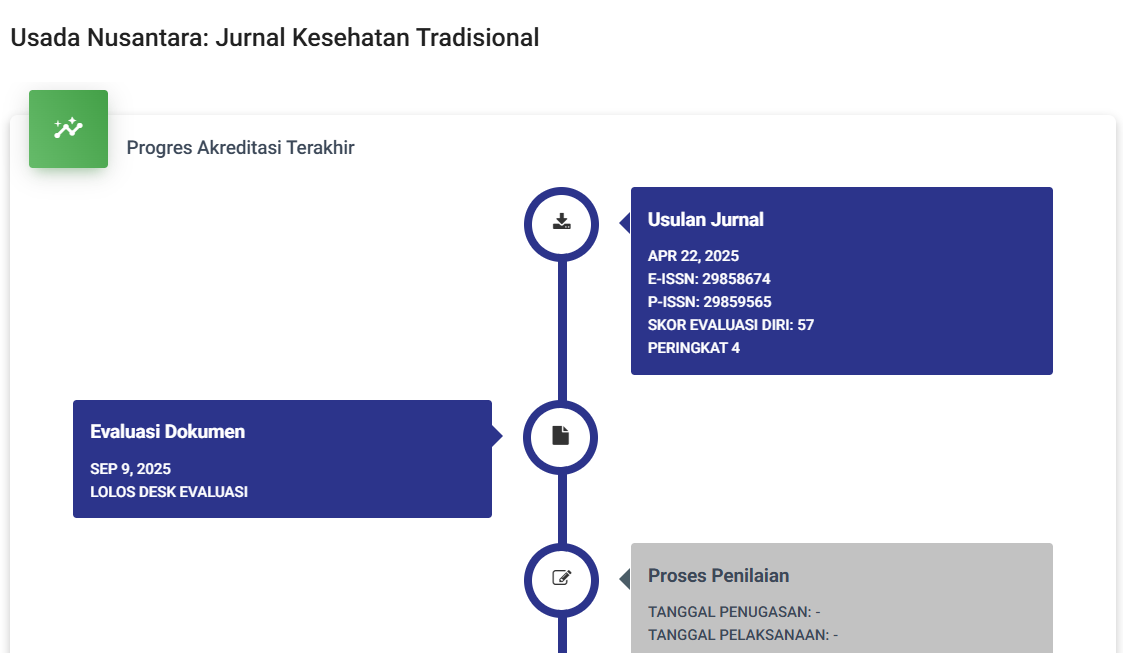Pengaruh Goji Berry (Lycium barbarum) Terhadap Kadar Glukosa Darah Puasa Dan Dua Jam Postprandial Pria Dewasa Normoglikemik
DOI:
https://doi.org/10.47861/usd.v1i2.386Keywords:
Goji berries, Lycium barbarum, blood glucose, Traditional Chinese MedicineAbstract
Background: Diabetes mellitus (DM) is a group of metabolic diseases characterized by hyperglycemia due to abnormal insulin secretion, insulin function or both. Based on World Health Organization, DM was the eighth leading cause of death in the world (2012), 43% of deaths happened at age less than 70 years. Microvascular and macrovascular complications caused by DM, long-term therapy, and side effects of therapy have greatly affected the patients’ quality of life. Hence, people have seeked many DM adjuvant therapy from herbs, one of which is goji berries [Lycium barbarum]. The Lycium barbarum polysaccharides (LBP) has been shown to have blood glucose lowering effect. Methods: This study aimed to investigate the effect of goji berries on reducing blood glucose levels. The research was conducted through pre and posttest design on fasting and two hours postprandial blood glucose levels in young adult males before and after receiving 20 g dried goji berries per day for 14 days. Statistical analysis used in this research was paired t test with α=0.05. Results: This study showed that the consumption of goji berries for 14 days did not significantly affect the fasting and two hours postprandial blood glucose levels (p>0.05) of the volunteers. Conclusion: Goji berries did not reduce fasting and two hours postprandial blood glucose levels in normoglycemic males.
References
Amagase H. General Toxicity and Histological Analysis from Acute Toxicological Study of a Standardized Lycium barbarum (Goji) Juice (GoChiTM) in Rodents. Faseb J. 2008; 2 : 722.
Bucheli P, Gao Q, Redgwell R, Karine V, Wang J, Zhang W. Biomolecular and Clinical Aspects of Chinese Wolfberry. In: Herbal Medicine: Biomolecular and Clinical Aspects. 2011; doi:10.1201/b10787-15.
Cai H, Liu F, Zuo P, Huang G, Song Z, Wang T et al. Practical application of antidiabetic efficacy of Lycium barbarum polysaccharide in patients with type 2 diabetes. Med Chem. 2015; 383-90. doi:10.2174/1573406410666141110153858.
Katzung BG, Masters SB, Trevor AJ. Basic & Clinical Pharmacology, 12th ed. McGraw-Hill; 2012.
Kulczyński B, Gramza-Michałowska A. Goji Berry (Lycium barbarum): Composition and Health Effects - A Review. Polish J Food Nutr Sci. 2016; 67-75. doi:10.1515/pjfns-2015-0040.
Li Q, Zhang GJ, Feng R, Fu XH, Mao JC, Wang Y. Clinical research of diabetic retinopathy treated with Tang-an-kang. J Chengdu Univ Trad Chin Med. 1999; 23-6.
Liu, W. J., Jiang, H. F., Rehman, F. U., Zhang, J. W., Chang, Y., Jing, L., & Zhang, J. Z. (2017). Lycium Barbarum Polysaccharides Decrease Hyperglycemia-Aggravated Ischemic Brain Injury through Maintaining Mitochondrial Fission and Fusion Balance. International journal of biological sciences, 13(7), 901–910. https://doi.org/10.7150/ijbs.18404
Luo Q, Wang Li J, Zhang SH. Effect of Lycium barbarum polysaccharides-X on reducing blood glucose in diabetic rabbits. Chin J Trophology. 1997; 173-7.
Madiyono B, Moeslichan M, Sastroasmoro S, Budiman I, Purwanto S. Dasar-dasar Metodologi Penelitian Klinis, 4th ed. Jakarta: Sagung Seto; 2011.
Masci, A., Carradori, S., Casadei, M. A., Paolicelli, P., Petralito, S., Ragno, R., & Cesa, S. (2018). Lycium barbarum polysaccharides: Extraction, purification, structural characterisation and evidence about hypoglycaemic and hypolipidaemic effects. A review. Food chemistry, 254, 377–389. https://doi.org/10.1016/j.foodchem.2018.01.176
McPherson RA, Pincus MR. Henry’s Clinical Diagnosis and Management by Laboratory Methods, 23rd ed. St. Louis, Missouri: Elsevier; 2017.
NICE.Type 2 diabetes: prevention in people at high risk. 2012. Available from: Overview | Type 2 diabetes: prevention in people at high risk | Guidance | NICE
Padila. Asuhan Keperawatan Penyakit Dalam. Yogyakarta: Nuha Medika; 2013.
PERKENI. Konsensus Pengelolaan dan Pencegahan Diabetes Melitus Tipe 2 di Indonesia 2015. PB PERKENI; 2015.
Pusat Data dan Informasi Kementerian Kesehatan RI. Infodatin: Situasi dan Analisis Diabetes. 2014.
Röder PV, Wu B, Liu Y, Han W. Pancreatic regulation of glucose homeostasis. Exp Mol Med. 2016; 48. doi:https://doi.org/10.1038/emm.2016.6.
Silva, C.S. & Alves, Beatriz & Azzalis, L.A. & Junqueira, V.B.C. & Fonseca, R. & Fonseca, A.L.A. & Fonseca, F.L.A.. (2017). Goji Berry (Lycium Barbarum) in the treatment of diabetes melitus: a systematic review. Food Research. 1. 221-224. 10.26656/fr.2017.6.102. http://dx.doi.org/10.26656/fr.2017.6.102
Tan SM (2008). Study on the hypoglycemic effect of wolfberry. J South Med Univ. 2008; 2103-4.
WHO. Global report on diabetes. 2016. 20-33.
Wojdyło A, Nowicka P, Bąbelewski P. Phenolic and carotenoid profile of new goji cultivars and their anti-hyperglycemic, anti-aging and antioxidant properties. J Funct Foods. 2018; 632-42. doi:10.1016/j.jff.2018.07.061.
Zhao R, Li Q, Xiao B. Effect of Lycium barbarum Polysaccharide on the Improvement of Insulin Resistance in NIDDM Rats. Yakugaku Zasshi. 2005; doi:10.1248/yakushi.125.981.








